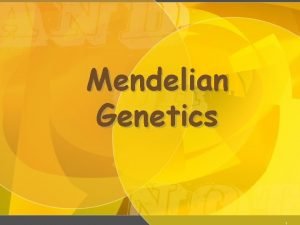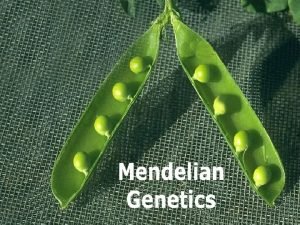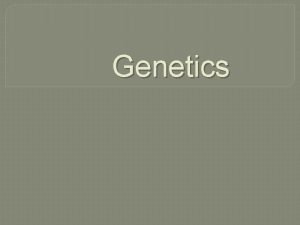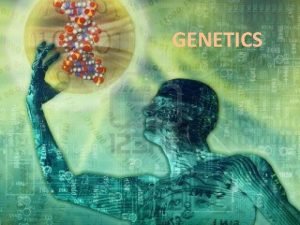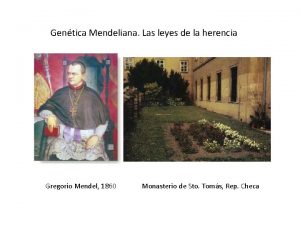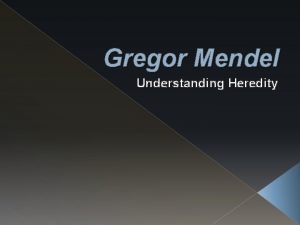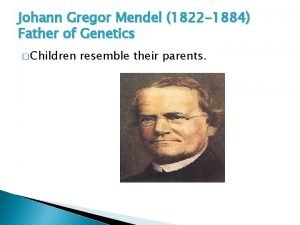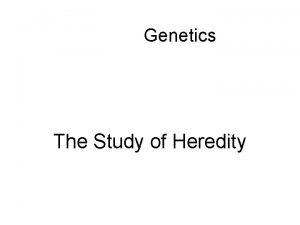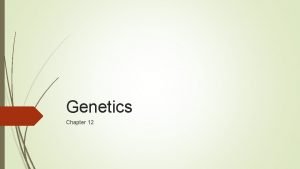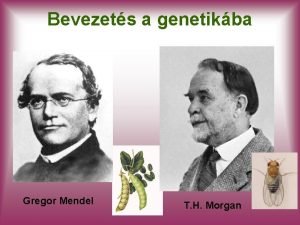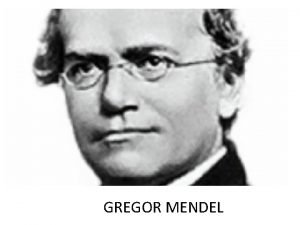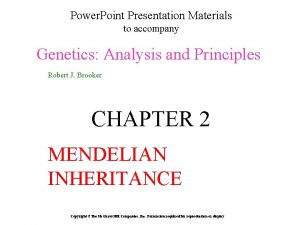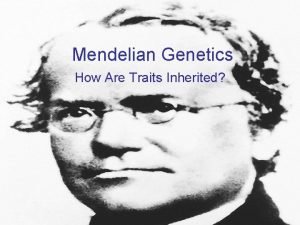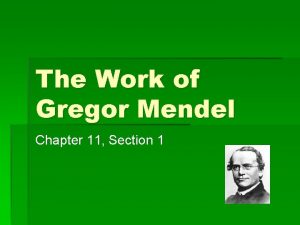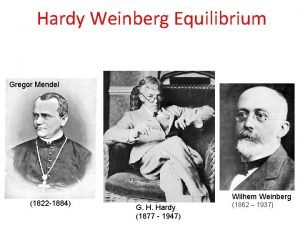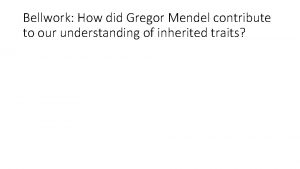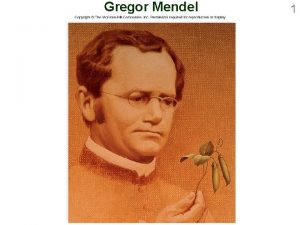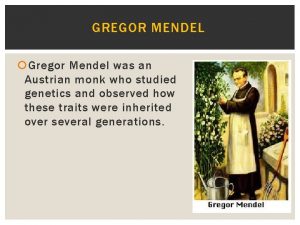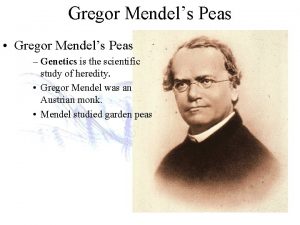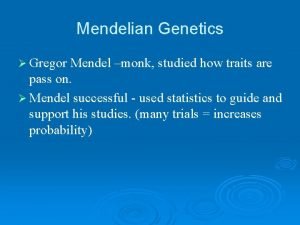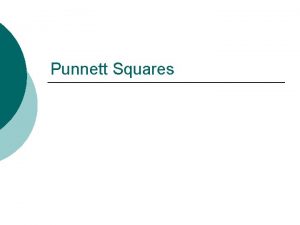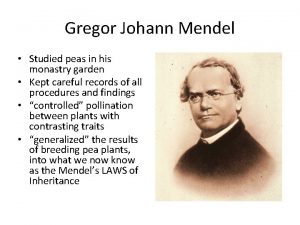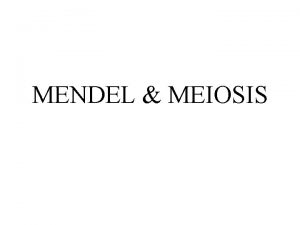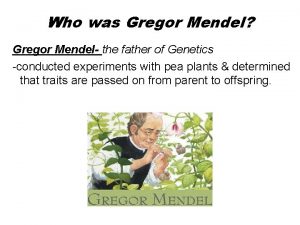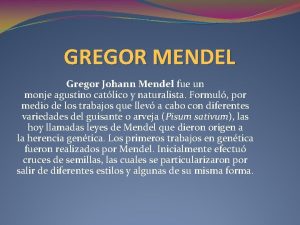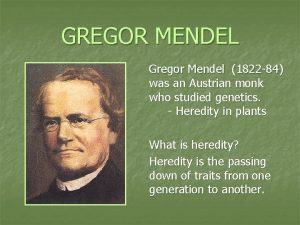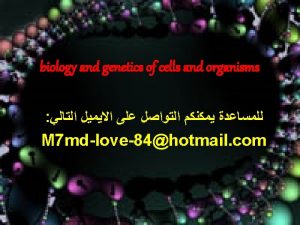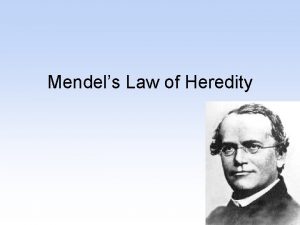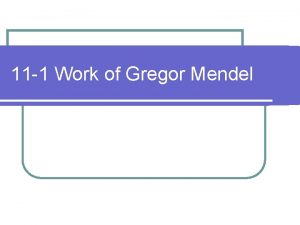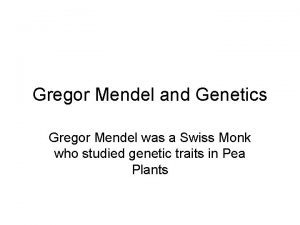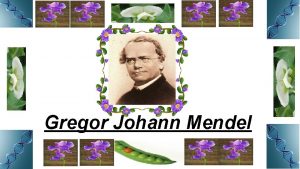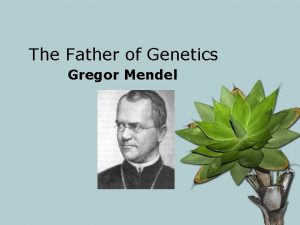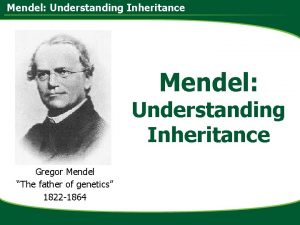Gregor Mendel n A monk who studied peas































- Slides: 31

Gregor Mendel n - A monk who studied peas in his garden and developed our basic understanding of heredity.

Allele n n n Alternate forms of a gene Most traits have 2 alleles Ex. Mendel’s peas

Blue eye or brown eye allele

Heredity n The transmission of characteristics from parents to offspring

Trait n The visible character that shows Ex. Yellow pea or green pea

Genes n A discrete unit of hereditary information located on a chromosome

Generations n n n P 1 Generation – The original parents F 1 Generation – The first offspring (Children) F 2 Generation – The offspring from the F 1 gen. (grandchildren)

Law of segregation n When gametes (sperm and egg) form, only one of the 2 possible genes for each trait will be in each gamete

Dominant vs. Recessive n n Dominant – The trait that is stronger or masks the other trait Recessive – The trait that is weaker or hidden

Dominant gene n Black fur is dominant to white

n If there are both a dominant and recessive traits together, only the dominant one appears

Genotype n The genes an organism carries n Ex: Gg = green (G) and yellow (g) genes G g

Phenotype n How the genes are expressed (what it looks like) Ex: Gg has both green and yellow genes but the phenotype is green because green is dominant

Homozygous Dominant Both Dominant Genes Present Genotype = GG Phenotype = Green n G G GG

Heterozygous 1 Dominant gene, 1 recessive gene present Genotype = Gg Phenotype = Green G g Gg

Homozygous Recessive Both recessive Genes Present Genotype = gg Phenotype = Yellow n g g gg

Monohybrid cross n Look at one single character

If we know the alleles of the parents, we can make predictions about the genetic traits of the offspring using A PUNNETT SQUARE! 1. 2. 3. 4. 5. 6. Draw a Punnett square Label 1 side with the genotype of one parent. Label the other side with the genotype of the other parent. Do the cross Describe genotypes including the possible percentages for the offspring Describe the phenotypes including the possible percentages for the

Punnett Square Practice 1. Curly hair (H) is dominant to straight hair (h). Draw a punnett square crossing a heterozygous male (Hh) with a heterozygous female (Hh). Name all possible gentoypes and phenotypes and the percentages. H H h h Genotypes: HH: Hh: hh: Phenotypes: Curly: Straight:

Punnett Square Practice 2. Dimples (D) are dominant to not having dimples (d). Draw a punnett square crossing a homozygous dominant female (DD) with a homozygous recessive male (dd). Name all possible genotypes and phenotypes and the percentages. d D D d Genotypes: DD: Dd: dd: Phenotypes: Dimples: No Dimples:

Punnett Square Practice 3. Unattached earlobes (E) are dominant to attached earlobes (e). Draw a punnett square crossing a homozygous recessive female with a heterozygous male. Name all possible genotypes and phenotypes and percentages. e Ee ee e Ee Genotypes: EE: Ee: ee: ee Phenotypes: Attached: Unattached:

Punnett Square Practice 4. Having freckles (F) is dominant to not having freckles (f). Draw a Punnett square crossing a heterozygous female with a homozygous dominant male. Name all possible genotypes and phenotypes and percentages. F f F FF Ff Genotype s: FF: 50% Ff: 50% Phenotyp es. Freckle s: 100%

Punnett Square Practice 5. Immunity to poison ivy is dominant to being susceptible to getting poison ivy. Draw a punnett square crossing a homozygous recessive female with a homozygous dominant male. Name all possible genotypes and phenotypes and percentages. i I Ii i Ii Genotype s: Ii: 100% Ii Phenotyp es. Immunit y: 100%

Punnett Square Practice 6. A widow’s peak is dominant to a normal hairline. Draw a punnett square crossing a heterozygous female with a heterozygous male. Name all possible genotypes and phenotypes and percentages. W w W WW Ww ww Genotype s: WW: 25% Ww: 50% ww: 25% Phenotyp es. Immunit y: Widows peak: 75% Normal:

Cases in Genetics with Filbert the Frog and Friends

S: smooth s: rough Y: yellow y: green Dihybrid Punnett Squares Genotypes: SSYY: 1/16 SSYy: 2/16 SSyy: 1/16 Ss. YY: 2/16 Ss. Yy: 4/16 Ssyy: 2/16 ss. YY: 1/ 16 ss. Yy: 2/16 ssyy: 1/16 Smooth Yellow: 9/16 Phenotypes: Rough Yellow: 3/16 Smooth green: 3/16 Rough green: 1/16

Now try to make one… B = black fur b = brown fur S = short fur s = long fur Genotypes: BBSs: 2/16 BBSS: 1/16 BBss: 1/16 Bb. SS: 2/16 Bb. Ss: 4/16 Bbss: 2/16 bb. SS: 1/16 bb. Ss: 2/16 bbss: 1/16 Phenotypes: Black, Short: 9/16 Brown, Short: 3/16 Black, Long: 3/16 Brown, Long: : 1/16 BBSS BBSs Bb. SS BBSs BBss Bb. Ss Bbss Bb. SS Bb. Ss bb. SS Bb. Ss Bbss bb. Ss

Try this one: BBSs vs. bb. Ss n Genotypes: n Phenotypes: B = black fur b = brown fur S = short fur s = long fur

BBSs n n BS Bs vs. bb. Ss n n b. S bs

Try this one: BBSs vs. bb. Ss n Genotypes: Bb. SS: 4/16 Bb. Ss: 8/16 Bbss: 4/16 BS B = black fur b = brown fur S = short fur s = long fur b. S bs b. S Bb. Ss Bb. SS Bb. Ss Bbss Bb. SS Bb. Ss Bb. SS Bs n Phenotypes: Black, Short: 12/16 Black, long: 4/16 BS Bs Bb. Ss bs

Homework: n n n Complete a dihybrid punnett square using this cross: Tt. RR x TTrr. Tall (T) is dominant to short (t) and Red (R) is dominant to pink (r). Find the genotype and phenotype percentages.
 Austrian monk
Austrian monk Austrian monk gregor mendel
Austrian monk gregor mendel What is the phenotype of a chicken with the genotype fbfw
What is the phenotype of a chicken with the genotype fbfw Pp x pp
Pp x pp Mendel monk
Mendel monk Mendel
Mendel Sebastian bach geboren
Sebastian bach geboren What did gregor mendel research
What did gregor mendel research Gregor mendel conclusions
Gregor mendel conclusions Who is gregor mendel and what is he famous for
Who is gregor mendel and what is he famous for Cruza dihibrida
Cruza dihibrida Mendel genetics
Mendel genetics Gregor mendel referat
Gregor mendel referat Gregor mendel laws
Gregor mendel laws Who was mendal
Who was mendal Gregor mendel chart
Gregor mendel chart Gregor mendel
Gregor mendel Gregor mendel
Gregor mendel Law of segregation anaphase 1
Law of segregation anaphase 1 What did gregor mendel do
What did gregor mendel do The work of gregor mendel lesson 1 chapter 12
The work of gregor mendel lesson 1 chapter 12 Section 11–1 the work of gregor mendel
Section 11–1 the work of gregor mendel Fr gregor mendel
Fr gregor mendel Gregor mendel
Gregor mendel Gregor mendel laws
Gregor mendel laws Gregor mendel
Gregor mendel Chapter 12 lesson 1 the work of gregor mendel
Chapter 12 lesson 1 the work of gregor mendel Gregor johann mendel
Gregor johann mendel Chapter 11 the work of gregor mendel
Chapter 11 the work of gregor mendel 5 conditions of hardy weinberg
5 conditions of hardy weinberg How did gregor mendel contribute to genetics
How did gregor mendel contribute to genetics Chapter 11 biology review answers
Chapter 11 biology review answers
